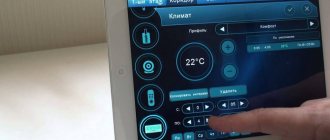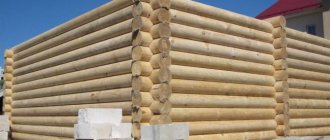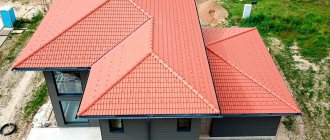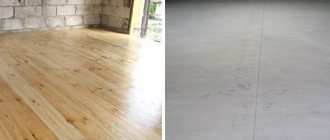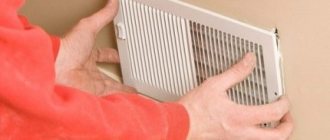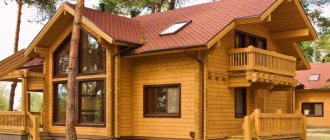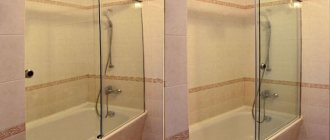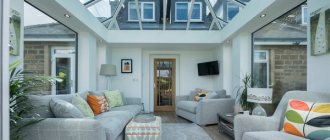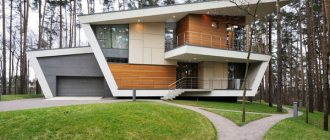Installation of a waterproofing membrane is a mandatory stage in the construction of any roof, ventilated façade or frame house. Waterproofing protects the insulation and wall, as well as the rafter system from moisture that can penetrate from the outside. At the same time, the membrane allows water vapor that rises from living spaces to ventilate freely. Thus, waterproofing materials significantly extend the life of all components of the roofing pie or facade.
But how to choose the type of waterproofing that is right for you? What determines its strength and effectiveness? We will talk about this in the article.
What is membrane roofing and its features
The membrane is a polymer film that is elastic, flexible and at the same time strong enough for outdoor use. The thickness of the material is 0.8–2 mm, the average specific gravity is 1.3 kg/m2.
Roofing membranes are available in two versions:
- without reinforcement;
- with reinforcement - a mesh of polyester fibers is integrated into the main material.
Membrane roofing can be used on various buildings
Scope of application
Membrane roofs can be used on various buildings, regardless of their purpose, on roofs with any slope. The exception is objects with increased fire safety requirements: polymers are combustible materials.
The material is laid only on a solid base. If the roof is trussed, a continuous sheathing is constructed.
Roofing membranes on rafter roofs are laid only on continuous sheathing
In addition to roofs, roofing membranes are used for waterproofing foundations, swimming pools, floors, and hydraulic structures.
Material storage
Taking into account the structure of membrane materials, the following requirements are imposed on its storage:
- the material is stored in packaged rolls, indoors or under a canopy;
- During long-term storage, rolls should be placed in a horizontal position;
- Rolls are stored in one row.
The storage location must be away from heating devices and other heat sources. Avoid exposure to direct sunlight and precipitation. Avoid icing.
Membrane roof design
In its structure, membrane roofing does not differ from structures covered with euroroofing felt. There are three varieties of it:
- flat classic;
- inversion;
- pitched with rafter system.
Flat roof classic
This is the name given to roofs covered with concrete slabs that are not intended for use. The roof consists of several layers, laid in this order (from bottom to top):
- concrete plates;
- vapor barrier film;
- insulation;
- cement-sand screed;
- roofing membrane;
- ballast for fixing the membrane (usually large crushed stone).
The laying pattern of the pie may vary slightly, depending on the base and slope of the roof.
Membrane roofing can be installed not only on concrete slabs, but also on corrugated sheets
Flat roof with inversion roofing
The base of this roof is also made of concrete slabs. It is intended for intensive use - up to the passage of vehicles. The name “inversion” roofing was given because the insulation and waterproofing coating swapped places. Here is the order of the layers (bottom to top):
- concrete plates;
- slope: a layer of lightweight concrete (expanded clay concrete or foam concrete) with a slight slope for water drainage;
- roofing membrane;
- extruded polystyrene foam (only this insulation can be used);
- drainage layer - crushed stone on a geotextile bedding: removes dirt from moisture penetrating through it, thereby preventing clogging of the drainage system;
- finishing coating: asphalt concrete, paving slabs or soil with lawn.
The roof in use is subject to significant loads
The insulation in this design must be durable and at the same time moisture resistant. Of the materials with low thermal conductivity (0.034 - 0.04 W/m*C), only extruded polystyrene foam meets these requirements.
Pitched roof with rafter system
Similar roofs are erected on most private houses. The layers in the structure are arranged like this (from the inside out):
- interior decoration;
- sheathing;
- sheathing;
- vapor barrier film;
- rafters with insulation boards located between them;
- diffusion or superdiffusion membrane;
- counter-lattice: forms a ventilated gap;
- continuous sheathing: two types are used - one- and two-layer;
- roofing membrane.
A roofing membrane on a pitched roof looks unpresentable, but it is sometimes used in private construction
In this option, the membrane is fixed instead of ballast (it will not stay on the slope) with special screws or other fasteners (depending on the material of the rafters).
Advantages and disadvantages of membrane roofing
The strengths of roofing membranes include:
- Resistance to all weather factors: high and low temperatures, temperature changes, oxidation, including ozone, ultraviolet radiation. Unlike bitumen and bitumen-polymer materials (roofing felt and euroroofing felt), membranes do not require a protective mineral powder.
- No pores. Thanks to this, the membrane does not collapse when frozen when wet, like bituminous materials. This quality is called frost resistance.
- Durability. Derived from the properties described in the first two paragraphs. The proven service life of polymer membranes is over 40 years, theoretical - 50 years. For comparison: bitumen-polymer materials last 15 years, bitumen - only 5 years.
- Low cost. Membrane roofing is much cheaper than coverings made of corrugated sheets, metal tiles and ceramic tiles. Compared to euroroofing felt, membranes are more expensive, but since bitumen-polymer materials more often require repairs, in the long term the cost of maintaining a membrane roof is half as low.
- Possibility of installation in the cold season. Euroroofing material becomes brittle in the cold, and the polymer membrane remains flexible on a rod with a diameter of 5 mm at temperatures down to -65 ° C (data for the CROMEL EPDM membrane).
- Single layer installation. For comparison: bitumen-polymer materials are laid in 3–5 layers.
- Possibility of installation on roofs with any slope. In contrast to membranes, materials containing bitumen with a slope of more than 25% slide in the heat.
- Minimum number of seams. Membrane sheets can reach a width of 15 m and a length of 60 m. For comparison: the width of a roll of bitumen-polymer material is 1 m, the length is 15–20 m. In addition, some types of membranes are heat welded, so that the coating is almost continuous (seamless ).
When laid by heat sealing, the membrane coating is continuous - High installation speed. In this parameter, membranes are superior to both bitumen-polymer and rigid coatings such as corrugated sheets and metal tiles.
- Light weight. With an average specific weight of 1.3 kg/m2, membranes create the least load on building structures among all coatings.
- Low fire load on the building. Polymer membranes are flammable, but since the thickness of this coating does not exceed 2 mm, when burning, unlike euroroofing material, they do not emit a large amount of heat and smoke.
- Elasticity. Polymer membranes can withstand significant stretching, some varieties - up to 400%. Thanks to this, deformations of the building do not lead to depressurization of the roof covering.
Disadvantages of membrane roofing:
- Lack of texture. On pitched roofs, a flat membrane does not look as impressive as tiles or at least corrugated sheeting.
- Low strength. Membranes can withstand high puncture forces, but are still much inferior in this parameter to hard coatings made of metal, ceramics, etc.
Types of roofing membranes
Membranes are made from different materials.
Ethylene-propylene-diene rubbers - EPDM and EPDM
In other words, these are rubber membranes (rubber is a product of vulcanization of natural and synthetic rubbers). The production of roofing membranes began with this technology in the 50s of the last century.
EPDM membranes are produced on the basis of rubbers
Advantages of the material:
- low cost;
- high elasticity: allow relative elongation up to 400%;
- resistance to oils, solvents and bitumen.
There is a significant drawback: the panels are connected by gluing, and the adhesive seam serves much less than the membrane itself. The coating must be regularly repaired by gluing the seams. At the same time, they can disperse much earlier than expected, which will lead to leaks.
This drawback prompts manufacturers to look for new materials for the production of membranes.
Polyvinyl chloride (PVC)
The next generation membranes, PVC, are thermoplastics - after heating to a state of plasticity and subsequent cooling, they retain their physical and chemical properties. This feature allows you to connect individual panels into a single coating using the heat welding method: the edges are heated with hot air at a temperature of 500–600 ° C and then pressed against each other, as a result of which mutual penetration of molecules occurs - the material is fused into a single whole.
Such a seam lasts as long as the membrane, and surpasses it in tensile strength.
In addition to PVC, the composition contains plasticizers and other additives.
The PVC membrane is a multilayer structure reinforced with a reinforcing mesh
Disadvantages of PVC membranes:
- high price;
- the need to use special equipment for connection;
- incompatibility with oils, solvents and bituminous materials (care must be taken during transportation).
The need to use welding equipment is the main reason that PVC membranes have not yet completely replaced rubber ones.
Thermoplastic olefins (TPO)
These membranes are also joined using heat sealing. Compared to PVC, they are more environmentally friendly: they do not emit harmful fumes, while PVC emits vinyl chloride gas. But the TPO coating is less elastic.
TPO membranes are inferior to polyvinyl chloride membranes in elasticity, but are superior to them in environmental friendliness
Superdiffusion membranes made of polyethylene and polypropylene
Unlike those described above, these membranes are not used as roofing. This is the so-called vapor-permeable waterproofing or wind protection, laid over rafters and insulation (outside) in rafter roof structures. Thanks to microperforation, the superdiffusion membrane allows steam to pass through, allowing it to evaporate from the insulation, but does not conduct moisture. That is, it acts as additional waterproofing in case of damage to the roofing.
The superdiffusion membrane easily allows water vapor to pass through, but is impermeable to water.
The use of a diffusion membrane instead of a conventional vapor-proof film provides double benefits:
- Instead of two ventilation gaps (above and below the waterproofing film), one is required - between the membrane and the roofing. This allows the use of thicker insulation.
- The insulation is protected from blowing, since there is no ventilated gap between it and the membrane. This enhances the thermal insulation effect.
Characteristics of diffusion membranes:
- Vapor permeability. This is the amount of steam passed through the membrane per unit time at a certain partial pressure. The unit of measurement is mg/m*h*Pa or mg/(sq. m*day). This parameter varies greatly for different brands of membranes. Membranes with low vapor permeability are called diffusion, and those with high vapor permeability are called superdiffusion.
- Strength. The stronger the membrane, the better. True, its cost also increases. Strength is characterized by tensile strength - the force required to tear a 5 cm wide sample.
- Elongation at break. Characterizes the elasticity of the membrane. The higher this parameter, the lower the likelihood of film damage.
- Stable under ultraviolet (UV) radiation. This term refers to the maximum period during which a membrane exposed to direct sunlight does not lose its qualities. The material is given limited resistance to UV rays because it will have to be exposed to the open air before installing the roofing or continuous sheathing. It is not advisable to give absolute resistance, like roofing membranes, since this leads to a significant increase in the cost of the product.
The stability period under UV radiation for diffusion membranes of different brands ranges from 1 to 6 months.
A ventilated gap above the membrane is created by stuffing counter-lattice onto the rafters.
Installation of membrane roofing
The installation of a membrane coating is carried out in several stages.
Laying
Rolls are rolled out without preparing the base. If there are sharp protrusions on it, two layers of geotextile are first laid.
When laying out membranes, four layers should not be allowed to overlap at the junctions of the panels.
The membrane panels are laid with an overlap:
- rubber: 150 mm;
- PVC and TPO: 70 mm when fixing the membrane with ballast and 120 mm when using mechanical fasteners.
TPO membranes can be secured using fasteners or using aluminum and galvanized steel strips
Connection of panels
Membrane sheets are connected by gluing or heat sealing.
Bonding (rubber membranes)
A special glue is used, purchased along with the membrane. A tape with a glossy surface is first placed between the edges to be glued so that the folds can be smoothed out and a tight fit can be achieved. After alignment, the tape is removed and the edges of the membranes are pressed against each other.
Glue is applied to both panels - bottom and top
Heat sealing (PVC and TPO)
Three types of welding machines are used:
- automatic: used on the main part of the coating, provide high speed of work (2–8 m/min);
- semi-automatic: used on vertical surfaces, parapets and other hard-to-reach areas;
- manual: for the most complex and hard-to-reach areas - curved or areas adjacent to vertical structures.
For high-quality welding, parameters (temperature, machine speed, etc.) must be maintained within the so-called welding window, that is, the permissible range. The boundaries of the latter depend on current weather conditions and, above all, air temperature. To determine the optimal parameters, test welding is first carried out on small samples. They select the settings until a seam of ideal strength is obtained (the material breaks outside the seam), and only then they begin to weld the membranes.
Membrane welding can be done manually or automatically
Making connections to vertical surfaces
The technology for sealing junctions depends on the material from which the membrane is made.
Rubber membranes
The connection is made according to the following scheme:
- the edge of the panel is glued to the vertical structure;
- bend the edge and fix it with a strip screwed with dowels;
- sealant is poured under the bend.
Fastening the panel to a vertical wall is done using fasteners
PVC and TPO
They work like this:
- a special steel strip in a plastic shell is screwed to the vertical structure with dowels, having previously applied a layer of sealant under it;
- cut a narrow strip from the unused membrane and weld it to the plastic shell of the rail;
- the other edge of the strip is welded to the main membrane covering.
The arrangement of the “pocket” protects against leaks
Fixing the membrane coating
For slopes up to 15°, the membrane is fixed using the ballast method, loading:
- crushed stone;
- paving slabs;
- any distributed load with a specific gravity of 50 kg/m2.
When using a weight with sharp edges, geotextiles are first laid under it.
For slopes over 15° or low load-bearing capacity of the roof, the membrane is screwed on with threaded fasteners:
- self-tapping screws;
- anchors.
Special fasteners are used - with large caps to prevent damage to the membrane. For slopes greater than 10°, disc holders are placed under them.
The roofing membrane can be fixed to the roof in three ways - ballast, mechanical and using glue
The mechanical method of fastening is allowed only for reinforced membranes.
If it is impossible to use ballast and mechanical fastening methods, the membrane is glued. The method combines high cost and low reliability, so it is used only as a last resort. Continuous gluing is not required: the membrane is fixed around the perimeter and at the junction of the panels.
Video: membrane roofing on a wooden base
Useful tips
Installing waterproofing is a simple process, but requires taking into account many nuances. Therefore, you need to follow certain rules:
- installation is carried out only in dry weather;
- if the roof has a small slope, it is recommended to lay the film in two layers;
- around the chimney the membrane is applied with a margin of 5–7 cm;
- the joints of the material are carefully sealed;
- for roofs with complex configurations, choose waterproofing with an adhesive layer;
- The film is applied to the valley sheets with an equal overlap;
- For fastening waterproofing, nails with wide heads are used.
The tightness of the waterproofing film depends not only on the correctness of the installation, but also on compliance with the production technology. Therefore, more attention should be paid to choosing a brand. Katepal roofing materials are thoroughly tested and meet European quality standards. Reliable Finnish waterproofing guarantees long-term protection of your home from leaks.
Membrane roof repair
It is necessary to repair the membrane coating in the following cases:
- the adhesive seam has come apart;
- when welding a TPO or PVC membrane, the material in a limited area was damaged due to overheating (temperature shock);
- the membrane is damaged due to careless actions when removing snow or other work.
In the first case, the unstuck seam is dried, degreased and glued back together.
In the rest, a patch is installed on the damaged area with dimensions larger than the defect by 50–100 mm in each direction. It is more correct to weld the patch to the PVC and TPO membrane, but the owner usually does not have welding equipment. Therefore, manufacturers offer a repair kit - a special self-adhesive tape (supplied in rolls).
The adhesive composition applied to it reacts with the membrane material, ensuring the tightness of the patch for a period of at least 30 years.
The repair tape is used as follows:
- The damaged area is cleaned of dust and dirt.
- Degrease with a special solvent that does not harm the membrane and the repair tape.
- Cut a piece of tape to the required length and paste it onto the defect.
- Roll the patch with a silicone or rubberized roller.
Small defects in membrane roofing can be eliminated with the help of patches.
The patch usually differs in color from the main coating, which is noticeable on roofs with a large slope. This drawback is eliminated by painting the membrane with light-resistant acrylic-based paint.
Video: step-by-step membrane roof repair technology
https://youtube.com/watch?v=riD0JXaoaDo
How to choose a membrane, mounting method and installation team
Deciding on the material and method of its installation is not easy. To do this, you usually have to contact specialists. However, this is the surest way: a reliable contractor relieves the customer of many problems and headaches, takes risks and responsibility for the project upon himself.
We will be happy to help you decide on a membrane roof and make the right choice taking into account the characteristics of your building and operating conditions. For your project, we will make calculations, actual measurements, order and deliver high-quality modern canvases, and also carry out installation work with a guarantee. We value our reputation, every customer is important to us, we work for results. Contact our consultants and engineers!
Leading membrane manufacturers
Roofing and under-roofing membranes are a sought-after material, which is why hundreds of companies around the world are engaged in their production. In our country, the products of the following brands are most widely represented: “Stroyplastpolymer”, “TechnoNIKOL”, “Tyvek”, “Strotex”.
"Stroyplastpolymer"
The joint-stock company "Stroyplastpolymer" was organized on the basis of a plant that has been operating since 1950. Located in Yekaterinburg. The company has a developed dealer network that allows you to purchase PVC membranes “from the manufacturer,” that is, without intermediary markups.
Two types of PVC membranes are available:
- "Roofing";
- "Plastfoil".
Plastfoil membranes have good waterproofing qualities.
The cost of a roll with dimensions of 2x20 m is 17.2–24 thousand rubles.
"TechnoNIKOL"
A large Russian concern, which has not only several factories, but also a research center. The latter is developing new technologies and materials. He created, for example, a unique “3-P” system, which increases the resistance of PVC to ultraviolet radiation. The technology is patented, the rights to it belong exclusively to the TechnoNIKOL concern.
produces membranes for regions with temperate, hot and cold climates
The company produces building materials in a very wide range, including several types of roofing membranes:
- Logicroof-Arctic. Reinforced PVC membrane for regions with cold climates. A 20-meter roll with a width of 2.1 m and a thickness of 1.5 mm costs 27,888 rubles.
- Logicproof VRP. Single-layer membrane with reinforcement. With a thickness of 1.2 mm, the cost of a roll measuring 2.05x25 m is 19 thousand rubles. A roll of 2.05x20 m (1.5 mm) costs 18.5 thousand rubles.
- Ecoplast VGR. The price of a roll 2.05x20 m (1.5 mm) is 13.5 thousand rubles.
- Plastroof VRP. With a thickness of 1.2 mm, the roll has dimensions of 2.05x25 m, the price is 14 thousand rubles. With a material thickness of 1.5 mm, the roll dimensions are 2.05x20 m, the cost is 14.3 thousand rubles.
Tyvek
The owner of the trademark is Dupont (USA). The manufacturer produces diffusion and superdiffusion membranes made of polyethylene. Product Features:
- has high strength with low weight;
- does not generate dust;
- has a smooth surface that does not interfere with water drainage.
Tyvek polyethylene membranes have a smooth surface that allows water to flow freely
Several types of under-roof diffusion membranes are offered:
- Soft. The membrane is single-layer, specific gravity is 80 g/m2. Elongation at break is more than 15%. Tensile strength of a 5 cm wide sample: 250 N. Operating temperature range: -73 to +100 °C. When exposed to ultraviolet radiation, the membrane retains its properties for 4 months. A roll (1.5 x 50 m) costs 4950 rubles.
- Solid. Membrane with reflective coating. Enhances the thermal insulation effect by reflecting infrared radiation. The price of a 50-meter roll with a width of 1.5 m is 6,500 rubles.
- AirGuard SD This membrane is used in attic roofs as a vapor barrier (laid under the rafters and insulation). Unlike conventional vapor barrier films, it allows steam to pass through, but to a limited extent, so that it is not enough for condensation in the insulation and on the rafters. The roof becomes “breathable”, which allows reducing the intensity of ventilation, and with it heat loss. Price - 9200 rub. per roll 1.5 x 50 m.
Strotex
Another manufacturer of diffusion and superdiffusion membranes is the Polish company Foliarex, owner of the Strotex trademark.
Strotex membranes are available in several versions - with increased, normal strength, and anti-condensation layer
Several varieties are offered:
- Strotex SL PP. The membrane is characterized by increased strength: the tensile strength of a sample 5 cm wide is 650–550 N. Stability under UV irradiation lasts 1 month.
- Strotex 110 PP. Membrane with normal strength - 300–250 N/5 cm. Stability period under UV radiation has been increased to 3 months.
- Strotex AC. Membrane with anti-condensation layer. The fleecy coating absorbs moisture, preventing it from flowing onto building structures. Then the water gradually evaporates, the steam is removed through a blown gap. This is the most durable representative of the line: tensile strength is 950–900 N/5 cm. UV resistance is also impressive: 6 months.
The average cost of Strotex products is 1000–2400 rubles/roll. (75 m2).
Popular brands
The most popular among consumers are membrane products from the following domestic and foreign manufacturers:
- “TechnoNikol”;
- “Stroyplastpolymer”;
- "Renolit";
- "Ruvitex";
- "Sika".
The TechnoNikol company supplies the market with three-layer PVC membranes. The range of products at Stroyplastpolymer is wider. This domestic manufacturer produces reinforced membranes for use as the top layers of roofing pie, as well as waterproofing products. The cost of products from Russian companies is from 400 rubles per 1 square meter, from foreign manufacturers - about 15 dollars.


